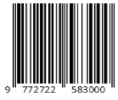Komposisi dan Pola Sebaran Lamun di Desa Garapia | Composition and distribution of seagrass in Garapia Village
Abstract
Tujuan penelitian ini adalah untuk mengetahui komposisi dan pola sebaran lamun di Perairan Laut Sulawesi Desa Garapia Kecamatan Monano Kabupaten Gorontalo Utara. Penelitian ini dilaksanakan pada Bulan September 2015 sampai Februari 2016. Metode yang digunakan adalah metode kuadran berukuran 1x1 meter. Lokasi penelitian dibagi menjadi 2 stasiun yaitu stasiun I (berdekatan dengan muara sungai dan pangkalan perahu) dan stasiun II (berdekatan dengan hutan mangrove). Komposisi jenis lamun di perairan Desa Garapia adalah Enhalus acoroides (13,29% dan 92,18%), Cymodoceae rotundata (46,43% dan 2,63%), Thalassia hemprichi (8,77% dan 2,86%), Halophila ovalis (18,26% dan 2,34%), Syringodium isoetifolium (13,25% dan 0%). Jenis lamun di perairan Laut Sulawesi Desa Garapia pada stasiun I untuk semua jenis lamun pola sebarannya mengelompok. Pada stasiun II, pola sebaran lamun terbagi atas beberapa kelompok yaitu: Pola sebaran seragam ditemukan pada Cymodocea ratundata dan Thalassia hemprichii, Pola sebaran acak terdapat pada Halophila ovalis, dan pola sebaran mengelompok terdapat pada Enhalus acoroides.
Composition and distribution of seagrass in Garapia Village. The purpose of this study was to determine the composition and pattern of seagrass distribution in the Sulawesi Sea of Garapia Village, Monano District, North Gorontalo Regency. This research was conducted in September 2015 to February 2016. The method used was a quadrant method measuring 1x1 meters. The research location was divided into 2 stations, namely Station I (adjacent to the river mouth and boat base) and Station II (adjacent to the mangrove forest). The composition of seagrass species in the waters of Garapia Village are Enhalus acoroides (13.29% and 92.18%), Cymodoceae rotundata (46.43% and 2.63%), Thalassia hemprichi (8.77% and 2.86%), Halophila ovalis (18.26% and 2.34%), Syringodium isoetifolium (13.25% and 0%). Seagrass species in the Sulawesi Sea, Garapia Village at Station I, for all types of seagrass, the distribution patterns are clustered. At Station II, seagrass distribution patterns are divided into several groups, namely: uniform distribution patterns found in Cymodocea ratundata and Thalassia hemprichii, random distribution patterns found on Halophila ovalis, and clustered distribution patterns found in Enhalus acoroides.
Kata kunci: Komposisi; pola sebaran; lamun; Laut Sulawesi
Keywords: Composition; distribution pattern; sea grass; Sulawesi Sea
Composition and distribution of seagrass in Garapia Village. The purpose of this study was to determine the composition and pattern of seagrass distribution in the Sulawesi Sea of Garapia Village, Monano District, North Gorontalo Regency. This research was conducted in September 2015 to February 2016. The method used was a quadrant method measuring 1x1 meters. The research location was divided into 2 stations, namely Station I (adjacent to the river mouth and boat base) and Station II (adjacent to the mangrove forest). The composition of seagrass species in the waters of Garapia Village are Enhalus acoroides (13.29% and 92.18%), Cymodoceae rotundata (46.43% and 2.63%), Thalassia hemprichi (8.77% and 2.86%), Halophila ovalis (18.26% and 2.34%), Syringodium isoetifolium (13.25% and 0%). Seagrass species in the Sulawesi Sea, Garapia Village at Station I, for all types of seagrass, the distribution patterns are clustered. At Station II, seagrass distribution patterns are divided into several groups, namely: uniform distribution patterns found in Cymodocea ratundata and Thalassia hemprichii, random distribution patterns found on Halophila ovalis, and clustered distribution patterns found in Enhalus acoroides.
Kata kunci: Komposisi; pola sebaran; lamun; Laut Sulawesi
Keywords: Composition; distribution pattern; sea grass; Sulawesi Sea
Full Text:
PDF (Bahasa Indonesia)DOI: https://doi.org/10.37905/.v6i2.5225
Refbacks
- There are currently no refbacks.
Copyright (c) 2020 Jurnal Nike








